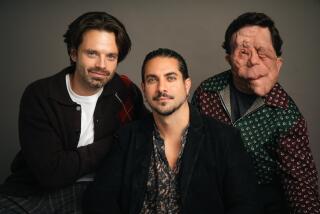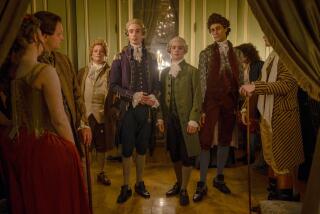‘Lincoln’ pierced ears, ‘Argo’ pecs? Talk about period drama
With his concave cheekbones, lanky build and grooved brow, Daniel Day-Lewis replicates Abraham Lincoln more accurately than the head of a penny.
His performance in “Lincoln” has earned rousing endorsements from Civil War historians, but close watchers of the film have spotted one glaring anachronism in this otherwise honest Abe — earring holes.
Day-Lewis, a meticulous actor known for disappearing into his roles, had the tattoos on his hands and forearms covered by wardrobe and makeup. He removed gold hoops from his ears. But despite makeup, the piercings were still visible.
“My Facebook friends were saying, ‘Gee, I never knew Abraham Lincoln had a pierced ear,’” said Scott Stoddart, a cinema and theater scholar and a dean at the Fashion Institute of Technology in New York. “You can see it in this scene and that scene. People are so visually literate now.”
Historical movies such as Steven Spielberg’s “Lincoln” have placed a greater premium on authenticity in recent years, with on-set researchers ensuring that costumes, production design and language accurately reflect the age. Filmmakers, however, have a more difficult time making sure the contemporary appearance of their casts doesn’t strain a movie’s credibility.
As a poor 19th century French factory worker in “Les Misérables,” Anne Hathaway incongruously shakes out the shiny, flowing tresses of a Pantene commercial. As a hard-drinking 1970s CIA agent in “Argo,” Ben Affleck peels off his shirt to show a torso sculpted enough for a Men’s Health cover. As a cigarette-smoking 1940s mafioso’s paramour in “Gangster Squad,” Emma Stone reveals an improbably pearly white smile.
Teeth whitening, plastic surgery, body piercings, weight training, healthful eating and yoga have made it a challenge to find the perfect period performer. Add the unforgiving nature of high-definition video on which more movies are made and seen and the emergence of visually savvy audiences, and you often have a recipe for historical dissonance.
Actors whose faces seem to belong more to the era of the daguerreotype than HD are becoming rare.
“The period face is going away from our culture,” said John Hawkes, 53, whose slight build and angular face have equipped him to play convincingly 19th century characters like a political operative in “Lincoln” and a merchant in the HBO western “Deadwood.” “Younger people are so much more handsome and beautiful than they were when I was growing up. Teeth are better. There’s better nutrition. We’re mutating into a more attractive species.”
Period dramas “Downton Abbey,” which re-creates life on a turn-of-the-century English estate, and “Mad Men,” which captures the style of the 1960s, have become staples on television. Historical films like “Lincoln” and “Les Misérables” have earned critical and financial success. Casting directors who can staff a period project are busier than ever.
PHOTOS: On the set of ‘Mad Men’
“‘Mad Men’ has movie people running scared,” Stoddart said. “The scrupulous detail has made everyone pay more attention to detail in the visual quality of period films.... They need to tell great stories, but they also need to take you into that other world in such a way that it overwhelms you.”
Avy Kaufman, casting director for “Lincoln,” spent eight months selecting an ensemble of more than 200 characters, many of whom can be described as having wonderfully imperfect, 19th century faces.
Nina Gold spent more than a year — twice as long as usual — filling parts in director Tom Hooper’s adaptation of “Les Misérables” with actors who could not only sing and act but also resemble 19th century French street urchins. Some of the musical’s stars, including Hathaway and Hugh Jackman, dropped weight to suit the era of deprivation. For the smaller parts, Gold tried to find people who came by their haggardness naturally.
“It was Tom’s fundamental note — these people have to look like they haven’t eaten since 1830,” said Gold, who also cast the period films “The King’s Speech” and “Iron Lady.” “They’ve never been to a doctor, and they don’t use moisturizer. If actors look too well fed and comfortable and like they just walked out of their well-appointed Winnebago, it just wouldn’t feel right. But to find the people who really are les misérables? There’s not many people in musical theater who look like that.”
Gold, who sifted through rafts of photos and sat through months of auditions, believes she has an advantage being based in London.
“English teeth are famously bad,” she said. “People are less perfect. If I go to lunch in a restaurant in London, there aren’t many people who’ve had their faces reconstructed. In L.A., nearly everybody has. In England, it’s easier to find interesting-looking people.”
While recruiting actors for the post-World War II, Paul Thomas Anderson drama, “The Master,” Cassandra Kulukundis had the tricky task of finding women for a nude scene set in the 1950s. She wanted to avoid piercings, plastic surgery and what she called “yoga bodies” for the party sequence, in which women of all ages and body types appear naked to one of the characters.
Anderson shot the scene on Mare Island in Northern California — hundreds of miles away from Hollywood-style grooming — where Kulukundis recruited average-looking non-actors for some of the roles.
“The people there look more natural than they do in L.A.,” Kulukundis said. “I don’t know how many were doing laser skin peels. They’re not plucked or bleached or what have you.”
Finding actors who didn’t hit the gym too hard is also a challenge. Meredith Tucker, who cast the music-driven coming of age story “Not Fade Away,” needed to track down young men sufficiently lithe to play musicians in a 1960s rock band. Tucker ended up casting slender, Dylanesque young actors John Magaro, Will Brill, and Jack Huston (grandson of director John Huston).
“When you have guys with those thick necks, that definitely takes you out of the story,” Tucker said. “Men did not have bodies like that back then.”
While character actors often better suit the aesthetic of period films, stars sell the movies at the box office.
PHOTOS: ‘Lincoln,’ ‘Argo,’ ‘Life of Pi’ recall Oscars’ past
As director of “Argo,” which is set during the 1979-81 Iran hostage crisis, Ben Affleck made sure his cast was groomed with sideburns and mustaches, and costumed in over-sized eyeglasses, all of which were popular at the time. But in his own role as CIA agent Tony Mendez, Affleck let slip one historical anomaly when he peeled off his shirt — and revealed his perfectly chiseled chest.
“We are not the people we were in the 1970s,” Affleck said, conceding that his body type was not typical for the era. But he said that detail was one of the less egregious historical imperfections in the film, which included a fabricated car chase on an airport runway.
When populating historical films, casting directors make a point of telling agents and actors what they don’t want.
A casting notice for a crowd scene in this summer’s “Lone Ranger” reboot specified for extras: “Must be able to portray 1800’s period look... no tattoos, no dyed hair, no highlights.” A notice for a U.K.-set period drama reads, “If you have a ring through your nose and a tattoo on your neck, please don’t waste time applying.”
Specificity doesn’t always weed out hopefuls, however. Tucker, who also casts 1920s-set “Boardwalk Empire,” said agents regularly send in actresses “with perfect white teeth, plumped-up lips and big fake boobs — to play a flapper! That just doesn’t work for us.”
Makeup can help, but it adds to the budget if actors in small parts have to be fitted for a set of bad teeth or sit through a tattoo coverup. Most casting directors said they try to avoid saddling productions with these problems.
Hollywood wasn’t always this fixated on such painstaking authenticity. In the past, period movies often drew as much on the look of the era in which they were shot as they did on the one they were depicting.
Julie Christie’s teased-up do in “Doctor Zhivago,” for instance, owes more to 1965 fashions than to imperial Russian ones, and the purple- and olive-hued costumes Barbra Streisand wore in “Funny Girl” evoked the movie musical’s 1968 release date more than a post-World War I look.
“It’s so obvious these movies are made in the ‘60s,” Stoddart said. “And that’s kind of the fun of it.”
Times staff writer John Horn contributed to this report.
PHOTOS AND MORE
VIDEO: The making of ‘Argo,’ ‘Les Miz’ and more
ENVELOPE: The latest awards buzz
PHOTOS: NC-17 movies: Ratings explained
More to Read
The biggest entertainment stories
Get our big stories about Hollywood, film, television, music, arts, culture and more right in your inbox as soon as they publish.
You may occasionally receive promotional content from the Los Angeles Times.











